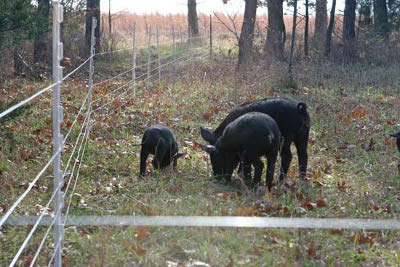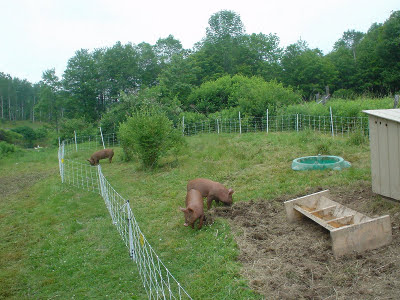
Other factors to consider when starting with pigs
 There are a slew of other
factors to consider when starting with pigs, but here are the top ones
on my radar:
There are a slew of other
factors to consider when starting with pigs, but here are the top ones
on my radar:
- Housing --- Each pig needs 8 to 10 square feet of sleeping space, preferably somewhere dry, draft-free, and out of the muck.
- Feeders and waterers --- Plan on one foot of trough space per hog or one self-feeder hole for three to five feeder pigs.
- Fencing --- Assuming
you're pasturing your pigs, you need to choose a fencing method and pay
attention to the where the fencing touches the ground. Unlike
many other farm animals, pigs like to go under rather than over fences
(although they'll go through them too if given the chance). Most
folks choose electric fencing, but we're going to go the
more-expensive-but-also-more-permanent route of stock panels.
Other options that work for pigs include pallets and woven wire.
 Preventing damage to the pasture
--- Many pastured pork producers put a ring on the end of their hogs'
noses to prevent rooting damage. On the other hand, others use
the rooting nature of pigs to their advantage by putting the
animals into an area where they want the current plant-life destroyed
--- we're using that route this first year. It's also worth
noting that sharp pig hooves will tear up pasture nearly as much as
their snouts do, especially in oft-traveled areas like around feed and
water stations.
Preventing damage to the pasture
--- Many pastured pork producers put a ring on the end of their hogs'
noses to prevent rooting damage. On the other hand, others use
the rooting nature of pigs to their advantage by putting the
animals into an area where they want the current plant-life destroyed
--- we're using that route this first year. It's also worth
noting that sharp pig hooves will tear up pasture nearly as much as
their snouts do, especially in oft-traveled areas like around feed and
water stations.- Keep them cool --- Hogs are naturally woodland creatures and need some shade in the summer.
- Plan your butchering before you
start --- Many homesteaders skin their hogs nowadays instead of
scalding them, but if you go that route, you'll lose most of the lard
and won't be able to cure the hams. (You'll still be able to cure
bacon after skinning.) So, don't buy a gilt and try to get her
really fat if you think you're going to skin.
What else would you
suggest new pig-keepers consider?
Interested in chickens
instead? Permaculture
Chicken: Pasture Basics walks you through creating a
simple pasture for your flock.
| This post is part of our Storey's Guide to Raising Pigs lunchtime
series.
Read all of the entries: |
Want more in-depth information? Browse through our books.
Or explore more posts by date or by subject.
About us: Anna Hess and Mark Hamilton spent over a decade living self-sufficiently in the mountains of Virginia before moving north to start over from scratch in the foothills of Ohio. They've experimented with permaculture, no-till gardening, trailersteading, home-based microbusinesses and much more, writing about their adventures in both blogs and books.
Want to be notified when new comments are posted on this page? Click on the RSS button after you add a comment to subscribe to the comment feed, or simply check the box beside "email replies to me" while writing your comment.
RSS
skinning pigs
Greetings Anna, I would have to argue skinning a pig will not prevent you from curing the hams and having adequate lard  Your right not many people or processors scald a pig anymore. We have butchered ourselves and also used local processors for our pigs every year and we have never used the scalding method. We cure and smoke our hams just fine. We also get plenty of lard because it does not all come from the back of a pig. The best kind is found covering the kidneys. Vicki
Your right not many people or processors scald a pig anymore. We have butchered ourselves and also used local processors for our pigs every year and we have never used the scalding method. We cure and smoke our hams just fine. We also get plenty of lard because it does not all come from the back of a pig. The best kind is found covering the kidneys. Vicki
 Your right not many people or processors scald a pig anymore. We have butchered ourselves and also used local processors for our pigs every year and we have never used the scalding method. We cure and smoke our hams just fine. We also get plenty of lard because it does not all come from the back of a pig. The best kind is found covering the kidneys. Vicki
Your right not many people or processors scald a pig anymore. We have butchered ourselves and also used local processors for our pigs every year and we have never used the scalding method. We cure and smoke our hams just fine. We also get plenty of lard because it does not all come from the back of a pig. The best kind is found covering the kidneys. Vicki
Comment by
Vicki
— Fri Mar 15 14:35:24 2013
- Remove comment
Add a comment
